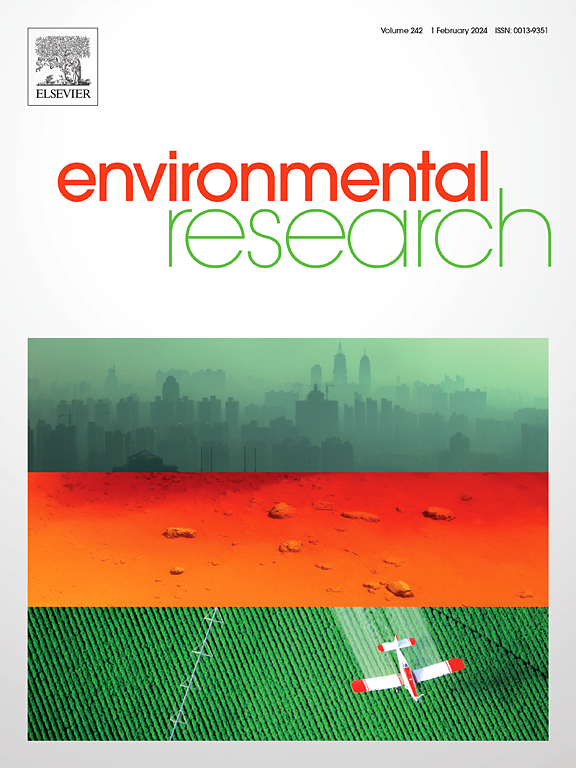Country-level antibiotic risk assessment in the multiple environmental matrices based on decennial data
IF 7.7
2区 环境科学与生态学
Q1 ENVIRONMENTAL SCIENCES
引用次数: 0
Abstract
The overuse of antibiotics has led to widespread environmental detection. However, country-level antibiotic risks from a global perspective remain unclear, highlighting a crucial need for antibiotic management worldwide. This study elucidated a global assessment of antibiotic detection frequencies and concentrations across various countries, compared detection levels of antibiotic classifications across compartments in representative countries, and conducted a risk assessment based on predicted no-effect concentrations (PNECs) for antibiotic resistance and minimum inhibitory concentrations (MICs) relevant to microbial nitrogen cycling. A decennial dataset comprising 431,441 records for 137 antibiotics across eight environmental compartments in 45 countries was analyzed. Results showed that Kenya (199 %) had the highest cumulative detection frequencies of four aqueous media. Wastewater from WWTPs (mean: 19.7 ng/L) and animal manure (mean: 2.6 μg/kg) exhibited the highest levels in aqueous and solid media, respectively. From sources to receptors, the highest antibiotic detections and concentrations were found in wastewater from WWTP, where quinolones dominated in France and the USA, and sulfonamides in Kenya (175−357 detections, median: 137−580 ng/L). Similarly, in surface water, sulfonamides were significant in Kenya and Vietnam, quinolones in Kenya (290−2049 detections, median: 32−70 ng/L). From the perspective of cumulative risk, Malaysia, China, and Canada are ranked the top three for both PNECs risk (81 %–191 %) and MICs risk (211 %–236 %). Whether for PNECs or MICs, sulfonamides are the most exceedance-prone antibiotic class across countries and also the highest-risk antibiotic class (median: 33 %). According to the total risk results from different countries, Malaysia (402 %) has the highest risk, followed by Canada (317 %) and China (315 %). The highest antibiotic risks were observed in Asia (medium SDG score), followed by Europe and the Americas (high SDG score), and Africa (low SDG score).
基于十年数据的多个环境矩阵中的国家级抗生素风险评估
抗生素的过度使用导致了广泛的环境检测。然而,从全球角度来看,国家一级的抗生素风险仍然不清楚,这突出了全球抗生素管理的迫切需要。本研究阐明了对各国抗生素检测频率和浓度的全球评估,比较了代表性国家各科室抗生素分类的检测水平,并根据抗生素耐药性的预测无效应浓度(PNECs)和微生物氮循环相关的最低抑制浓度(mic)进行了风险评估。对45个国家8个环境隔间中137种抗生素的431,441条记录进行了十年一次的数据集分析。结果表明,肯尼亚(199%)4种水介质的累计检出率最高。污水处理厂废水(平均值:19.7 ng/L)和动物粪便(平均值:2.6 μg/kg)在水介质和固体介质中含量最高。从来源到受体,在污水处理厂的废水中发现了最高的抗生素检测和浓度,其中喹诺酮类药物在法国和美国占主导地位,磺胺类药物在肯尼亚占主导地位(检测到175 ~ 357个,中位数:137 ~ 580 ng/L)。同样,在地表水中,磺胺类药物在肯尼亚和越南含量显著,喹诺酮类药物在肯尼亚含量显著(290 ~ 2049次检测,中位数:32 ~ 70 ng/L)。从累积风险的角度来看,马来西亚、中国和加拿大在pnec风险(81% - 191%)和MICs风险(211% - 236%)方面均排名前三。无论是中等收入国家还是中等收入国家,磺胺类抗生素都是各国最容易过量使用的抗生素类别,也是风险最高的抗生素类别(中位数:33%)。根据不同国家的总风险结果,马来西亚(42%)的风险最高,其次是加拿大(317%)和中国(315%)。抗生素风险最高的地区是亚洲(可持续发展目标得分中等),其次是欧洲和美洲(可持续发展目标得分高)和非洲(可持续发展目标得分低)。
本文章由计算机程序翻译,如有差异,请以英文原文为准。
求助全文
约1分钟内获得全文
求助全文
来源期刊

Environmental Research
环境科学-公共卫生、环境卫生与职业卫生
CiteScore
12.60
自引率
8.40%
发文量
2480
审稿时长
4.7 months
期刊介绍:
The Environmental Research journal presents a broad range of interdisciplinary research, focused on addressing worldwide environmental concerns and featuring innovative findings. Our publication strives to explore relevant anthropogenic issues across various environmental sectors, showcasing practical applications in real-life settings.
 求助内容:
求助内容: 应助结果提醒方式:
应助结果提醒方式:


